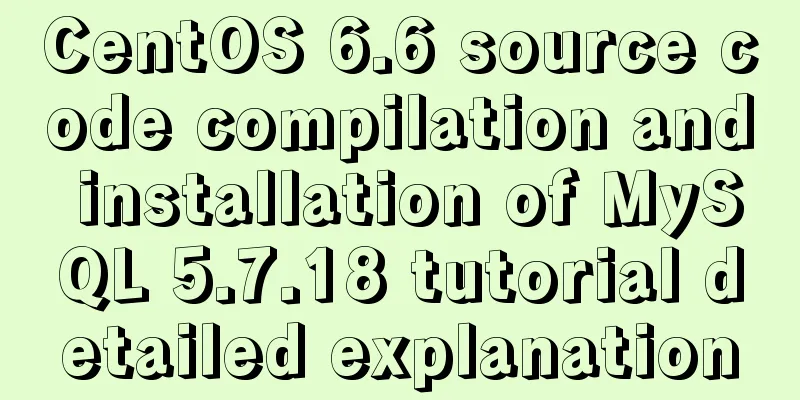CentOS 6.4 MySQL 5.7.18 installation and configuration method graphic tutorial

|
The specific steps of installing mysql5.7.18 under centos6.4 are shared with everyone. 1. First check whether MySQL has been installed and find the MySQL related software rpm package #rpm -qa | grep mysql
2. Delete everything related to mysql #yum -y remove mysql-libs-5.1.66-2.el6_3.x86_64
3. Install dependency packages #yum -y install make gcc-c++ cmake bison-devel ncurses-devellibaio libaio-devel
4. Create a mysql user group #groupadd mysql 5. Create user mysql under the mysql user group #useradd mysql -g mysql 6. Download mysql-5.7.19-linux-glibc2.12-x86_64.tar.gz from the official website Download address: https://dev.mysql.com/downloads/mysql/ 7. Put mysql-5.7.19-linux-glibc2.12-x86_64.tar in the /opt folder 8. Unzip the file mysql-5.7.19-linux-glibc2.12-x86_64.tar.gz #tar xzvfmysql-5.7.19-linux-glibc2.12-x86_64.tar.gz 9. Rename mysql-5.7.19-linux-glibc2.12-x86_64 to mysql and move it to /usr/local/mysql #mv mysql-5.7.19-linux-glibc2.12-x86_64 /usr/local/mysql Create a data directory under /usr/local/mysql #mkdir /usr/local/mysql/data 10. Return to the local directory #cd /usr/local Change the main content of the mysql directory and the files and subdirectories below it to mysql #chown -R mysql:mysql mysql/ Grant 755 permissions to the mysql directory and its files and subdirectories #chmod -R 755 mysql/ 11. Compile, install and initialize mysql, remember the password at the end of the command line #/usr/local/mysql/bin/mysqld --initialize --user=mysql --datadir=/usr/local/mysql/data --basedir=/usr/local/mysql
12. Start the mysql service #/usr/local/mysql/support-files/mysql.server start
13. Make a soft connection and restart the MySQL service #ln -s /usr/local/mysql/support-files/mysql.server /etc/init.d/mysql #service mysql restart 14. Make a soft link and put mysql in the installation directory in the /usr/bin directory #ln -s /usr/local/mysql/bin/mysql /usr/bin 15. Log in to msyql and enter the password (the password is the password generated by initialization in step 11) #mysql -u root -p
16. Change the password to 123456 msql>alter user 'root'@'localhost' identified by '123456'; mysql>use mysql; msyql>update user set user.Host='%' where user.User='root'; mysql>flush privileges; mysql>quit 17. Edit my.cnf, add the configuration file, and configure the content as follows #vi /usr/local/mysql/my.cnf [mysqld] port = 3306 sql_mode=NO_ENGINE_SUBSTITUTION,STRICT_TRANS_TABLES 18. Allow port 3306 #iptables -I INPUT -p tcp -m state --state NEW -m tcp --dport 3306 -j ACCEPT #iptables -L -n #service iptables save The above is the full content of this article. I hope it will be helpful for everyone’s study. I also hope that everyone will support 123WORDPRESS.COM. You may also be interested in:
|
<<: React uses emotion to write CSS code
>>: Solution to slow network request in docker container
Recommend
HTML simple shopping quantity applet
This article shares a simple HTML shopping quanti...
iframe parameters with instructions and examples
<iframe src=”test.jsp” width=”100″ height=”50″...
Detailed explanation of the working principle and usage of the Docker image submission command commit
After creating a container locally, you can creat...
The DOCTYPE mode selection mechanism of well-known browsers
Document Scope This article covers mode switching...
Detailed explanation of how to build phalcon environment under nginx server on centos7 system
This article describes how to build a phalcon env...
Vue imports excel table, and automatically downloads the data that failed to import
There is such a requirement: an import button, cl...
How to clean up Alibaba Cloud MySQL space
Today I received a disk warning notification from...
Tomcat first deployment web project process diagram
Put your own web project in the webapps directory...
MySQL 5.7.17 installation and configuration tutorial for Mac
1. Download MySQL Click on the official website d...
Detailed explanation of compatibility issues and solutions for setting max-width and min-width in table
Setting min-width and max-width properties in tab...
Example of converting JavaScript flat array to tree structure
Table of contents 10,000 pieces of data were lost...
5 Steps to Implement Responsive Web Design Method and Say Goodbye to Waterfall Model (Graphic Tutorial)
Congratulations on finally convincing your bosses...
Detailed explanation of Linux Namespace User
User namespace is a new namespace added in Linux ...
How to install docker using YUM
As shown in the following figure: If the version ...
Customization Method of Linux Peripheral File System
Preface Generally speaking, when we talk about Li...















